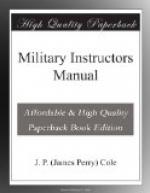LESSON 7. (CLASSROOM—FOUR HOURS.)
PROBLEM.—Completing the map sketch previously made and making a landscape sketch.
It is important to complete a map and no matter how good it is, if certain points are omitted, the value of the work is very much decreased. The sketcher must clear the sketch of all unnecessary lines and notes and make his lettering clear on the map. Be sure that the following items are on the sketch before it is turned in.
1. Location of the ground shown.
2. Line of magnetic north shown
by an arrow, and if declination is
known, the true north also.
3. Graphic scale and representative
fraction—R.F.
4. Vertical interval—V.I.
5. Sketcher’s name and
organization to which he belongs.
6. Date.
A landscape sketch is a place sketched with details shown in perspective. The horizon is always of military importance and should be shown as well as intervening crests, woods, houses, etc. Landscape sketching in trench warfare is a necessary accomplishment of the observer. The beginner will at first be confused by a mass of details, but he must note only the outline of the features sketched. First draw the sky line and crests, then fill in the other details with fewest lines possible. Unnecessary shading tends to detract from the clearness of the sketch. There will be great difficulty in getting the perspective, note the size of objects, the further away they are the smaller they seem. Make them so. In making the sketch, hold the pad in front with one eye closed, the upper edge of the pad horizontal; a string 20 inches long is tied to the pad and held between the teeth to insure the same distance from the eye each time. Moreover, if it is desired to locate objects by deflection of an angle from a reference point, this can be done by using mils. One mil is 1-6400 of a circle. At 20 inches a half-inch interval subtends 25 mils.
[Illustration: Plate #11]
The paper is oriented by bringing the sector desired along the upper edge of the pad. The points desired are then in proper positions, both horizontally and vertically.
Place a mark at the upper edge for points desired. The sky line should be located first. Now carry these lines down, having drawn three horizontal lines about 1/2 inch apart, beginning with the highest point on the top line. Marks locating the other features are likewise transposed in vertical and horizontal portions.




